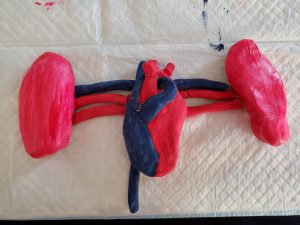The lungs and the heart are two separate organs that interact. “The heart maintains blood flow, and the muscles of the chest wall and diaphragm ventilate the lung. Most importantly, the proper match between these functions maintains adequate P O2 gradients which direct the O2 flow through the system.” In simple terms, the heart is used to supply blood that transports oxygen to the muscles in the chest wall and diaphragm, creating a negative pressure to expand the lungs, which we know as breathing. This is one way the heart and lungs interact. This is also a possible cause of why people who experience chest pains also have a hard time catching their breath. Without adequate blood flow, the muscles needed to create the negative pressure that expands the lungs will not receive oxygen, resulting in the inability to function correctly. This is why Doctors and EMS personnel will often focus on how the heart is performing when people are experiencing chest pains and difficulty breathing. “The structural design sets up a sequence of closely linked compartments. It establishes a system of airway tubes for ventilation of the gas exchanger and a system of blood vessels for orderly circular blood flow. It also establishes close contact between air and blood and between blood and cells for efficient gas exchange. The subcellular structure organizes the relation between mitochondria and the cellular elements that require ATP to perform the cells’ functions.”
We can see the heart and lungs’ interaction when we compare a healthy heart to a failing heart. “Interestingly, the specific effects of intrathoracic pressure swings on left heart function differ between healthy and HF (Heart Failure) patients. Whereas the ‘healthy’ heart is positioned on the steep portion of the Frank Starling operating curve, the ‘failing’ heart is shifted rightward and upward onto the flatter, stiffer portion of this curve.” A failing heart cannot pump blood and exchange the gasses adequately compared to a healthy heart. “Accordingly, while left ventricular output of the ‘healthy’ heart changes in proportion with variations in left ventricular preload, the ‘failing’ heart does not and instead varies in proportion to changes in afterload.” A healthy heart works to maintain an efficient preload before the left ventricle contracts to support blood flow to the lungs for oxygenation dependent on the person’s activity level. A failing heart can not keep this, so it will create changes in the afterload phase, which is after the left ventricle contracts. The effect of a failing heart does not support efficient oxygenations. This means that a person with heart failure can experience difficulty breathing and low O2 stats. This is why EMS personnel provide oxygen to boost the O2 stats to alleviate the chest pains caused by a lack of oxygenation.

Anthony examines how our lungs and heart work closely together and how having an unhealthy heart will directly affect our lungs which explains why people who are having chest pain, or any difficulties to their heart, will experience difficulties breathing. He explains that the negative pressure that comes from the heart contracting to push out oxygenated blood to the muscles, causes an expansion in the lungs which is how we are able to breathe. The gas exchange that occurs in our bodies to create ATP and give the muscles enough energy to contract also plays an important role in the heart and lungs connection as it helps to establish a system of airway tubes as well as blood vessels for circular blood flow allowing for close contact of the air, blood and cells. Anthony goes on to examine the differences between the intrathoracic pressure swings of a healthy heart vs unhealthy and how it affects the lungs. For example a healthy heart is located on the steeper portion of the Frank Starling operating curve and can efficiently preload before the left ventricle in order to keep up with one’s activity levels and pump blood. While an unhealthy heart is shifted rightward onto the flat and stiff portion of the curve. Due to this the unhealthy heart can not keep up with variations in the left ventricle preload so it has to create changes in the after-load phase instead and is not able to keep up with one’s activity level and bring oxygen to the lungs by pumping blood efficiently.